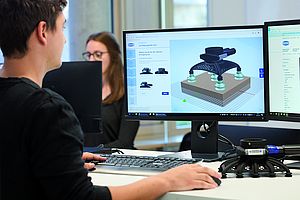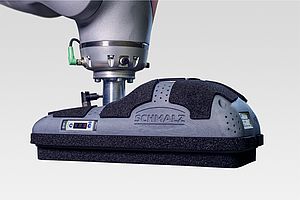J. Schmalz has developed a special cover for its vacuum area gripping system FXP/FMP. It can be used, for instance, to grip even very thin glass gently and without scratching. The gripping system can also use the protective cover made from a special mesh in cleanroom applications.
FXP area gripping system with protective cover for gentle handling of sensitive workpieces. The integrated valve technology on the area gripping systems and the soft, adaptable sealing foam together with the small suction cells allow workpieces of different shapes and sizes to be handled gently. If operators also fit their FXP/FMP area gripping systems with the new protective cover, they can transport items like thin display glass along the entire assembly line without damaging them.
Workpieces with coated and polished surfaces can also be handled without scratching them. The combination of area gripper and protective cover is also an efficient tool in the manufacture of glass sheets in the building and automotive sector. Furthermore, area gripping systems with the special mesh are certified for use in cleanroom classes 2 to 6.
The foam surface of the gripper has small vacuum chambers that evenly distribute the required suction force onto the part to be lifted. It is especially gentle on the material when combined with the special mesh. Unlike other suction processes, shearing forces due to suction cup lips standing at an angle cannot be produced while using an area gripper with foam. As a result, relative movement between the suction cup lip and the surface is avoided: The plastic does not rub against the workpiece while picking it up and therefore cannot cause abrasion. The sensitive surfaces remain undamaged.
The user benefits from a system that is easy to operate and maintain. Dirty protective covers can be replaced quickly and easily thanks to a separable adhesive bond. The pattern of holes defined on the mesh layer allows sufficient quantities of air to flow through at all times. That ensures high process reliability and the optimum adjusted surface pressure.



















